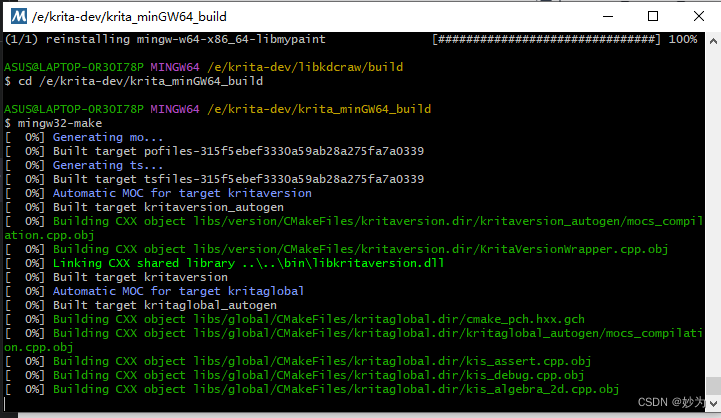嗨害大家好鸭!我是爱摸鱼的芝士❤

宠物真的看着好治愈
谁不想有一只属于自己的乖乖宠物捏~
这篇文章中我放弃了以往的model.fit()训练方法,
改用model.train_on_batch方法。
两种方法的比较:
- model.fit():用起来十分简单,对新手非常友好
- model.train_on_batch():封装程度更低,可以玩更多花样。
此外我也引入了进度条的显示方式,更加方便我们及时查看模型训练过程中的情况,可以及时打印各项指标。
🚀 我的环境:
- 语言环境:Python3.6.5
- 编译器:jupyter notebook
- 深度学习环境:TensorFlow2.4.1
- 显卡(GPU):NVIDIA GeForce RTX 3080

一、前期工作
1. 设置GPU
如果使用的是CPU可以注释掉这部分的代码。
import tensorflow as tf
gpus = tf.config.list_physical_devices("GPU")
if gpus:
tf.config.experimental.set_memory_growth(gpus[0], True)
tf.config.set_visible_devices([gpus[0]],"GPU")
print(gpus)
PhysicalDevice(name='/physical_device:GPU:0', device_type='GPU')]
2. 导入数据
import matplotlib.pyplot as plt
plt.rcParams['font.sans-serif'] = ['SimHei']
import os,PIL
import numpy as np
np.random.seed(1)
import tensorflow as tf
tf.random.set_seed
import warnings
warnings.filterwarnings('ignore')
import pathlib
data_dir = "./data/train"
data_dir = pathlib.Path(data_dir)
3. 查看数据
image_count = len(list(data_dir.glob('*/*')))
print("图片总数为:",image_count)
图片总数为:3400

二、数据预处理
1. 加载数据
使用image_dataset_from_directory
方法将磁盘中的数据加载到tf.data.Dataset中
batch_size = 8
img_height = 224
img_width = 224
TensorFlow版本是2.2.0的同学可能会遇到
module ‘tensorflow.keras.preprocessing’ has no attribute 'image_dataset_from_directory’的报错,
升级一下TensorFlow就OK了
train_ds = tf.keras.preprocessing.image_dataset_from_directory(
data_dir,
validation_split=0.2,
subset="training",
seed=12,
image_size=(img_height, img_width),
batch_size=batch_size)
Found 3400 files belonging to 2 classes.
Using 2720 files for training.
val_ds = tf.keras.preprocessing.image_dataset_from_directory(
data_dir,
validation_split=0.2,
subset="validation",
seed=12,
image_size=(img_height, img_width),
batch_size=batch_size)
Found 3400 files belonging to 2 classes.
Using 680 files for validation.
我们可以通过class_names输出数据集的标签。标签将按字母顺序对应于目录名称。
class_names = train_ds.class_names
print(class_names)
['cat', 'dog']
2. 再次检查数据
for image_batch, labels_batch in train_ds:
print(image_batch.shape)
print(labels_batch.shape)
break
(8, 224, 224, 3)
(8,)
Image_batch是形状的张量(8, 224, 224, 3)。这是一批形状224x224x3的8张图片(最后一维指的是彩色通道RGB)。
Label_batch是形状(8,)的张量,这些标签对应8张图片
3. 配置数据集
- shuffle() :打乱数据,关于此函数的详细介绍可以参考:https://zhuanlan.zhihu.com/p/42417456
- prefetch() :预取数据,加速运行,其详细介绍可以参考我前两篇文章,里面都有讲解。
- cache() :将数据集缓存到内存当中,加速运行
AUTOTUNE = tf.data.AUTOTUNE
def preprocess_image(image,label):
return (image/255.0,label)
train_ds = train_ds.map(preprocess_image, num_parallel_calls=AUTOTUNE)
val_ds = val_ds.map(preprocess_image, num_parallel_calls=AUTOTUNE)
train_ds = train_ds.cache().shuffle(1000).prefetch(buffer_size=AUTOTUNE)
val_ds = val_ds.cache().prefetch(buffer_size=AUTOTUNE)
如果报 AttributeError: module ‘tensorflow._api.v2.data’ has no attribute ‘AUTOTUNE’ 错误,就将 AUTOTUNE = tf.data.AUTOTUNE 更换为 AUTOTUNE = tf.data.experimental.AUTOTUNE,这个错误是由于版本问题引起的。
4. 可视化数据
plt.figure(figsize=(15, 10))
for images, labels in train_ds.take(1):
for i in range(8):
ax = plt.subplot(5, 8, i + 1)
plt.imshow(images[i])
plt.title(class_names[labels[i]])
plt.axis("off")


三、构建VG-16网络
VGG优缺点分析:
- VGG优点
VGG的结构非常简洁,整个网络都使用了同样大小的卷积核尺寸(3x3)和最大池化尺寸(2x2)。
- VGG缺点
1)训练时间过长,调参难度大。2)需要的存储容量大,不利于部署。例如存储VGG-16权重值文件的大小为500多MB,不利于安装到嵌入式系统中。
结构说明:
- 13个卷积层(Convolutional Layer),分别用blockX_convX表示
- 3个全连接层(Fully connected Layer),分别用fcX与predictions表示
- 5个池化层(Pool layer),分别用blockX_pool表示
VGG-16包含了16个隐藏层(13个卷积层和3个全连接层),故称为VGG-16
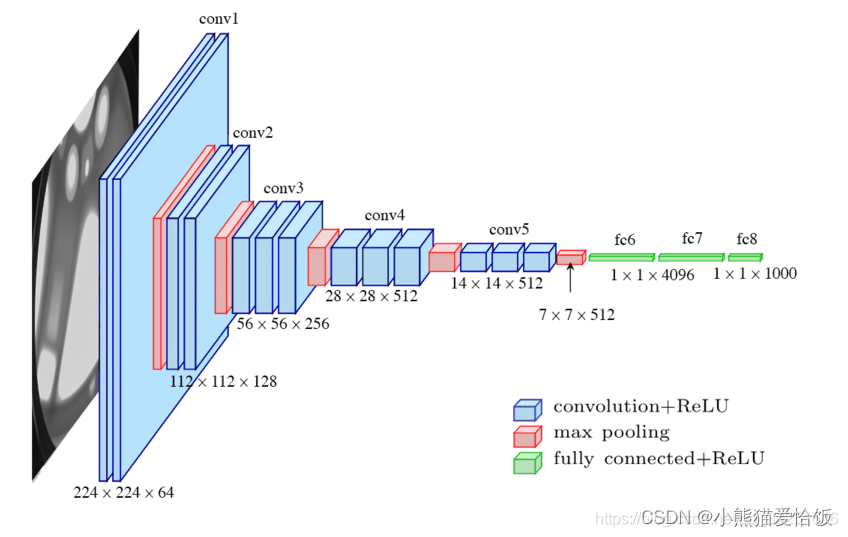

from tensorflow.keras import layers, models, Input
from tensorflow.keras.models import Model
from tensorflow.keras.layers import Conv2D, MaxPooling2D, Dense, Flatten, Dropout
def VGG16(nb_classes, input_shape):
input_tensor = Input(shape=input_shape)
# 1st block
x = Conv2D(64, (3,3), activation='relu', padding='same',name='block1_conv1')(input_tensor)
x = Conv2D(64, (3,3), activation='relu', padding='same',name='block1_conv2')(x)
x = MaxPooling2D((2,2), strides=(2,2), name = 'block1_pool')(x)
# 2nd block
x = Conv2D(128, (3,3), activation='relu', padding='same',name='block2_conv1')(x)
x = Conv2D(128, (3,3), activation='relu', padding='same',name='block2_conv2')(x)
x = MaxPooling2D((2,2), strides=(2,2), name = 'block2_pool')(x)
# 3rd block
x = Conv2D(256, (3,3), activation='relu', padding='same',name='block3_conv1')(x)
x = Conv2D(256, (3,3), activation='relu', padding='same',name='block3_conv2')(x)
x = Conv2D(256, (3,3), activation='relu', padding='same',name='block3_conv3')(x)
x = MaxPooling2D((2,2), strides=(2,2), name = 'block3_pool')(x)
# 4th block
x = Conv2D(512, (3,3), activation='relu', padding='same',name='block4_conv1')(x)
x = Conv2D(512, (3,3), activation='relu', padding='same',name='block4_conv2')(x)
x = Conv2D(512, (3,3), activation='relu', padding='same',name='block4_conv3')(x)
x = MaxPooling2D((2,2), strides=(2,2), name = 'block4_pool')(x)
# 5th block
x = Conv2D(512, (3,3), activation='relu', padding='same',name='block5_conv1')(x)
x = Conv2D(512, (3,3), activation='relu', padding='same',name='block5_conv2')(x)
x = Conv2D(512, (3,3), activation='relu', padding='same',name='block5_conv3')(x)
x = MaxPooling2D((2,2), strides=(2,2), name = 'block5_pool')(x)
# full connection
x = Flatten()(x)
x = Dense(4096, activation='relu', name='fc1')(x)
x = Dense(4096, activation='relu', name='fc2')(x)
output_tensor = Dense(nb_classes, activation='softmax', name='predictions')(x)
model = Model(input_tensor, output_tensor)
return model
model=VGG16(1000, (img_width, img_height, 3))
model.summary()
Model: "model"
_________________________________________________________________
Layer (type) Output Shape Param #
=================================================================
input_1 (InputLayer) [(None, 224, 224, 3)] 0
_________________________________________________________________
block1_conv1 (Conv2D) (None, 224, 224, 64) 1792
_________________________________________________________________
block1_conv2 (Conv2D) (None, 224, 224, 64) 36928
_________________________________________________________________
block1_pool (MaxPooling2D) (None, 112, 112, 64) 0
_________________________________________________________________
block2_conv1 (Conv2D) (None, 112, 112, 128) 73856
_________________________________________________________________
block2_conv2 (Conv2D) (None, 112, 112, 128) 147584
_________________________________________________________________
block2_pool (MaxPooling2D) (None, 56, 56, 128) 0
_________________________________________________________________
block3_conv1 (Conv2D) (None, 56, 56, 256) 295168
_________________________________________________________________
block3_conv2 (Conv2D) (None, 56, 56, 256) 590080
_________________________________________________________________
block3_conv3 (Conv2D) (None, 56, 56, 256) 590080
_________________________________________________________________
block3_pool (MaxPooling2D) (None, 28, 28, 256) 0
_________________________________________________________________
block4_conv1 (Conv2D) (None, 28, 28, 512) 1180160
_________________________________________________________________
block4_conv2 (Conv2D) (None, 28, 28, 512) 2359808
_________________________________________________________________
block4_conv3 (Conv2D) (None, 28, 28, 512) 2359808
_________________________________________________________________
block4_pool (MaxPooling2D) (None, 14, 14, 512) 0
_________________________________________________________________
block5_conv1 (Conv2D) (None, 14, 14, 512) 2359808
_________________________________________________________________
block5_conv2 (Conv2D) (None, 14, 14, 512) 2359808
_________________________________________________________________
block5_conv3 (Conv2D) (None, 14, 14, 512) 2359808
_________________________________________________________________
block5_pool (MaxPooling2D) (None, 7, 7, 512) 0
_________________________________________________________________
flatten (Flatten) (None, 25088) 0
_________________________________________________________________
fc1 (Dense) (None, 4096) 102764544
_________________________________________________________________
fc2 (Dense) (None, 4096) 16781312
_________________________________________________________________
predictions (Dense) (None, 1000) 4097000
=================================================================
Total params: 138,357,544
Trainable params: 138,357,544
Non-trainable params: 0
_________________________________________________________________

四、编译
在准备对模型进行训练之前,还需要再对其进行一些设置。以下内容是在模型的编译步骤中添加的:
- 损失函数(loss):用于衡量模型在训练期间的准确率。
- 优化器(optimizer):决定模型如何根据其看到的数据和自身的损失函数进行更新。
- 评价函数(metrics):用于监控训练和测试步骤。以下示例使用了准确率,即被正确分类的图像的比率。
model.compile(optimizer="adam",
loss ='sparse_categorical_crossentropy',
metrics =['accuracy'])

五、训练模型
from tqdm import tqdm
import tensorflow.keras.backend as K
epochs = 10
lr = 1e-4
# 记录训练数据,方便后面的分析
history_train_loss = []
history_train_accuracy = []
history_val_loss = []
history_val_accuracy = []
for epoch in range(epochs):
train_total = len(train_ds)
val_total = len(val_ds)
"""
total:预期的迭代数目
ncols:控制进度条宽度
mininterval:进度更新最小间隔,以秒为单位(默认值:0.1)
"""
with tqdm(total=train_total, desc=f'Epoch {epoch + 1}/{epochs}',mininterval=1,ncols=100) as pbar:
lr = lr*0.92
K.set_value(model.optimizer.lr, lr)
for image,label in train_ds:
"""
训练模型,简单理解train_on_batch就是:它是比model.fit()更高级的一个用法
想详细了解 train_on_batch 的同学,
可以看看我的这篇文章:https://mtyjkh.blog.csdn.net/article/details/119506151
"""
history = model.train_on_batch(image,label)
train_loss = history[0]
train_accuracy = history[1]
pbar.set_postfix({"loss": "%.4f"%train_loss,
"accuracy":"%.4f"%train_accuracy,
"lr": K.get_value(model.optimizer.lr)})
pbar.update(1)
history_train_loss.append(train_loss)
history_train_accuracy.append(train_accuracy)
print('开始验证!')
with tqdm(total=val_total, desc=f'Epoch {epoch + 1}/{epochs}',mininterval=0.3,ncols=100) as pbar:
for image,label in val_ds:
history = model.test_on_batch(image,label)
val_loss = history[0]
val_accuracy = history[1]
pbar.set_postfix({"loss": "%.4f"%val_loss,
"accuracy":"%.4f"%val_accuracy})
pbar.update(1)
history_val_loss.append(val_loss)
history_val_accuracy.append(val_accuracy)
print('结束验证!')
print("验证loss为:%.4f"%val_loss)
print("验证准确率为:%.4f"%val_accuracy)
Epoch 1/10: 100%|████████| 340/340 [00:23<00:00, 14.36it/s, loss=1.1077, accuracy=0.6250, lr=9.2e-5]
开始验证!
Epoch 1/10: 100%|█████████████████████| 85/85 [00:02<00:00, 36.55it/s, loss=0.9331, accuracy=0.6250]
结束验证!
验证loss为:0.9331
验证准确率为:0.6250
Epoch 2/10: 100%|███████| 340/340 [00:19<00:00, 17.49it/s, loss=0.4633, accuracy=0.6250, lr=8.46e-5]
......
Epoch 9/10: 100%|███████| 340/340 [00:19<00:00, 17.36it/s, loss=0.0112, accuracy=1.0000, lr=4.72e-5]
开始验证!
Epoch 9/10: 100%|█████████████████████| 85/85 [00:01<00:00, 43.46it/s, loss=0.0302, accuracy=1.0000]
结束验证!
验证loss为:0.0302
验证准确率为:1.0000
Epoch 10/10: 100%|██████| 340/340 [00:19<00:00, 17.22it/s, loss=0.0000, accuracy=1.0000, lr=4.34e-5]
开始验证!
Epoch 10/10: 100%|████████████████████| 85/85 [00:02<00:00, 42.15it/s, loss=0.0231, accuracy=1.0000]
结束验证!
验证loss为:0.0231
验证准确率为:1.0000
# 这是我们之前的训练方法。
# history = model.fit(
# train_ds,
# validation_data=val_ds,
# epochs=epochs
# )

六、模型评估
epochs_range = range(epochs)
plt.figure(figsize=(12, 4))
plt.subplot(1, 2, 1)
plt.plot(epochs_range, history_train_accuracy, label='Training Accuracy')
plt.plot(epochs_range, history_val_accuracy, label='Validation Accuracy')
plt.legend(loc='lower right')
plt.title('Training and Validation Accuracy')
plt.subplot(1, 2, 2)
plt.plot(epochs_range, history_train_loss, label='Training Loss')
plt.plot(epochs_range, history_val_loss, label='Validation Loss')
plt.legend(loc='upper right')
plt.title('Training and Validation Loss')
plt.show()
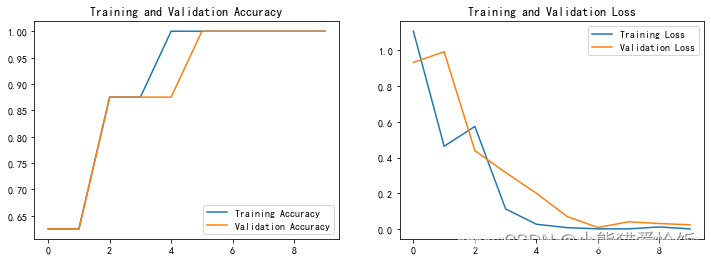

七、保存and加载模型
这是最简单的模型保存与加载方法哈
# 保存模型
model.save('model/21_model.h5')
# 加载模型
new_model = tf.keras.models.load_model('model/21_model.h5')
八、预测
plt.figure(figsize=(18, 3))
plt.suptitle("预测结果展示")
for images, labels in val_ds.take(1):
for i in range(8):
ax = plt.subplot(1,8, i + 1)
plt.imshow(images[i].numpy())
img_array = tf.expand_dims(images[i], 0)
predictions = new_model.predict(img_array)
plt.title(class_names[np.argmax(predictions)])
plt.axis("off")




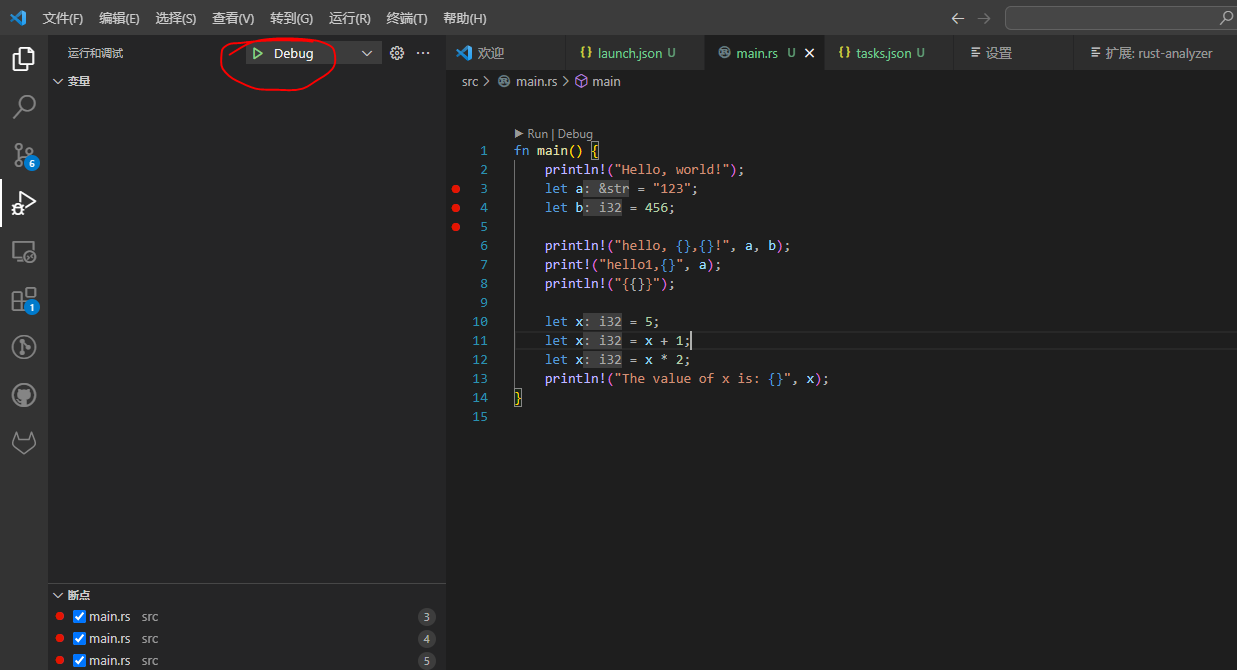

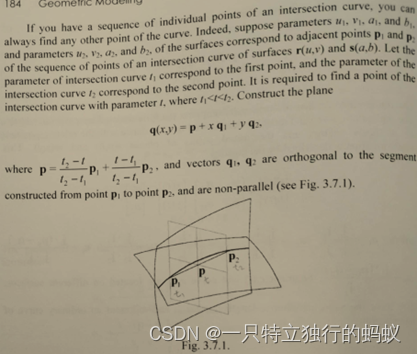







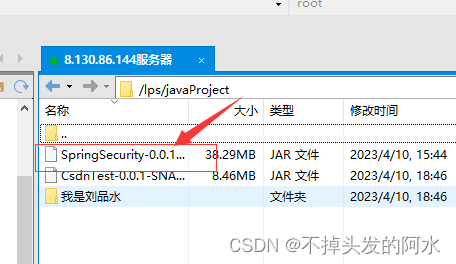

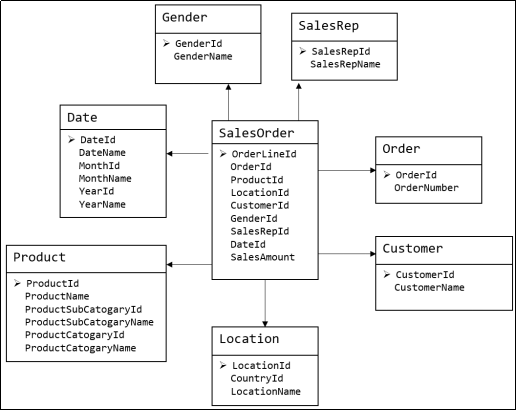

![[JavaEE]----Spring03](https://img-blog.csdnimg.cn/abd888e6246e43fcb6a199e363d2300d.png)

